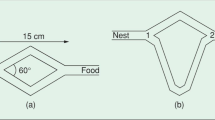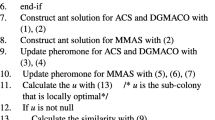Abstract
Constraint satisfaction problem (CSP) is a fundamental problem in the field of constraint programming. To tackle this problem more efficiently, an improved ant colony optimization algorithm is proposed. In order to further improve the convergence speed under the premise of not influencing the quality of the solution, a novel strengthened pheromone updating mechanism is designed, which strengthens pheromone on the edge which had never appeared before, using the dynamic information in the process of the optimal path optimization. The improved algorithm is analyzed and tested on a set of CSP benchmark test cases. The experimental results show that the ant colony optimization algorithm with strengthened pheromone updating mechanism performs better than the compared algorithms both on the quality of solution obtained and on the convergence speed.



Similar content being viewed by others
References
Rouahi A, Salah KB, Ghédira K (2015) Belief constraint satisfaction problems. In: IEEE/ACS international conference of computer systems and applications. IEEE
Ranft B, Stiller C (2016) The role of machine vision for intelligent vehicles. IEEE Trans Intell Vehi 1(1):8–19
Ekwongmunkong W, Mittrapiyanuruk P, Kaewtrakulpong P (2016) Automated machine vision system for inspecting cutting quality of cubic zirconia. IEEE Trans Inst Meas 65(9):2078–2087
Vidovic M, Hwang HJ, Amsuss S et al (2015) Improving the robustness of myoelectric pattern recognition for upper limb prostheses by covariate shift adaptation. IEEE Trans Neural Syst Rehabil Eng 24(9):961–970
Adewuyi AA, Hargrove LJ, Kuiken TA (2016) An analysis of intrinsic and extrinsic hand muscle emg for improved pattern recognition control. IEEE Trans Neural Syst Rehabil Eng Publ IEEE Eng Med Biol Soc 24(4):1
Zhang C, Lin Q, Gao L et al (2015) Backtracking search algorithm with three constraint handling methods for constrained optimization problems. Expert Syst Appl 42(21):112–116
Xu W, Gong F (2016) Performances of pure random walk algorithms on constraint satisfaction problems with growing domains. J Comb Optim 32(1):51–66
Narjess D, Sadok BA (2016) New hybrid GPU-PSO approach for solving Max-CSPs. In: Proceedings of the genetic and evolutionary computation conference companion. ACM
Dali N, Bouamama S (2015) GPU-PSO: parallel particle swarm optimization approaches on graphical processing unit for constraint reasoning: case of Max-CSPs. Proc Comput Sci 60(1):1070–1080
Breaban M, Ionita M, Croitoru C (2007) A new PSO approach to constraint satisfaction. In: IEEE congress on evolutionary computation, 2007. CEC 2007. IEEE, pp 1948–1954
Hemert JIV (2015) Evolutionary computation and constraint satisfaction, springer handbook of computational intelligence. Springer, Berlin, pp 1271–1288
Sharma A (2015) Analysis of evolutionary operators for ICHEA in solving constraint optimization problems. In: IEEE congress on evolutionary computation, CEC 2015. IEEE, Sendai, pp 46–53. doi:10.1109/CEC.2015.7256873
Karim MR, Mouhoub M (2014) Coevolutionary genetic algorithm for variable ordering in CSPs. In: IEEE congress on evolutionary computation. pp 2716–2723
Craenen BGW, Eiben AE, van Hemert JI (2003) Comparing evolutionary algorithms on binary constraint satisfaction problems. IEEE Trans Evol Comput 7(5):424–444
Aratsu Y, Mizuno K, Sasaki H et al (2013) Experimental evaluation of artificial bee colony with greedy scouts for constraint satisfaction problems. In: Conference on technologies and applications of artificial intelligence. IEEE Computer Society, pp 134–139
Aratsu Y, Mizuno K, Sasaki H et al (2013) Solving constraint satisfaction problems by artificial bee colony with greedy scouts. Proc World Congr Eng Comput Sci 1(1):1–6
Yang Q (2008) A comparative study of discrete differential evolution on binary constraint satisfaction problems. In: IEEE congress on evolutionary computation, CEC 2008. IEEE, Hong Kong, pp 330–335. doi:10.1109/CEC.2008.4630818
Mizuno K, Hayakawa D, Sasaki H et al (2011) Solving constraint satisfaction problems by ACO with cunning ants. In: International conference on technologies and applications of artificial intelligence. IEEE Computer Society, pp 155–160
Solnon C (2002) Ants can solve constraint satisfaction problems. IEEE Trans Evol Comput 6(4):347–357
Tarrant F, Bridge D (2005) When ants attack: ant algorithms for constraint satisfaction problems. Artif Intell Rev 24(3–4):455–476
Goradia HJ (2013) Ants with limited memory for solving constraint satisfaction problems. In: IEEE congress on evolutionary computation, CEC 2013. IEEE, Cancun, pp 1884–1891. doi:10.1109/CEC.2013.6557789
Gonzalez-Pardo A, Camacho D (2013) A new CSP graph-based representation for ant colony optimization. In: IEEE congress on evolutionary computation, 2013. CEC 2013. IEEE, Cancun, pp 689–696. doi:10.1109/CEC.2013.6557635
Mavrovouniotis M, Yang S (2014) Ant colony optimization with self-adaptive evaporation rate in dynamic environments. In: IEEE symposium on computational intelligence in dynamic and uncertain environments (CIDUE). pp 47–54
Stützle T, Hoos HH (2000) MAX–MIN ant system. Future Gener Comput Syst 16:889–914
Zhang Z, Feng Z (2009) A novel Max–Min ant system algorithm for traveling salesman problem. In: IEEE international conference on intelligent computing and intelligent systems. IEEE, pp 508–511
Lin JY, Chen YP (2011) Analysis on the collaboration between global search and local search in memetic computation. IEEE Trans Evol Comput 15(5):608–623
Macintyre E, Prosser P, Smith B et al (1998) Random constraint satisfaction: theory meets practice. Springer, Berlin
Fan Y, Shen J (2011) On the phase transitions of random k-constraint satisfaction problems. Artif Intell 175(3–4):914–927
Acknowledgements
This work was supported by the National Natural Science Foundation Program of China (61572116, 61572117, 61602105), CERNET Innovation Project (NGII20160126), and the Special Fund for Fundamental Research of Central Universities of Northeastern University (N150408001, N150404009).
Author information
Authors and Affiliations
Corresponding author
Ethics declarations
Conflict of interest
We declare that we have no financial and personal relationships with other people or organizations that can inappropriately influence our work, and there is no professional or other personal interest of any nature or kind in any product, service and/or company that could be construed as influencing the position presented in or the review of the manuscript entitled, “An improved ant colony optimization algorithm with strengthened pheromone updating mechanism for constraint satisfaction problem.”
Rights and permissions
About this article
Cite this article
Zhang, Q., Zhang, C. An improved ant colony optimization algorithm with strengthened pheromone updating mechanism for constraint satisfaction problem. Neural Comput & Applic 30, 3209–3220 (2018). https://doi.org/10.1007/s00521-017-2912-0
Received:
Accepted:
Published:
Issue Date:
DOI: https://doi.org/10.1007/s00521-017-2912-0




